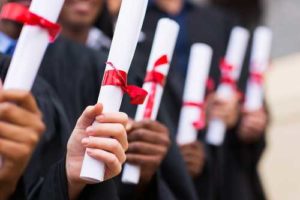Forward-thinking practices focus on college and career readiness
 As the skills expected of today’s graduates change rapidly, school districts have to overhaul their thinking on what it means to be “college and career ready.” Conventional wisdom around when and where students learn, what knowledge they need to be successful, and who they are as learners is all rapidly changing, especially as technology becomes more prevalent in classrooms.
As the skills expected of today’s graduates change rapidly, school districts have to overhaul their thinking on what it means to be “college and career ready.” Conventional wisdom around when and where students learn, what knowledge they need to be successful, and who they are as learners is all rapidly changing, especially as technology becomes more prevalent in classrooms.
This is all top of mind for members of the Digital Promise League of Innovative Schools, a coalition of around 57 forward-thinking districts and leaders across the country, who are committed to improving the opportunity to learn for all of their students through technology and research. We rounded up some best practices League members use to ensure students stay in school, get their degrees, and are prepared for success in their post-secondary endeavors.
Learning can happen anytime, anywhere
Geographic and socio-economic factors no longer have to be barriers to learning. Schools don’t even have to be limited by the confines of the school day. Piedmont City School District is a remote, rural part of northeast Alabama. Many students’ families could not afford computers, or even an internet connection. It is difficult for the 1,200-student district to offer STEM, foreign language or Advanced Placement courses year-round.
Yet every student in Piedmont is given a laptop in school and to take home and, through partnerships developed by the district, can access free or low-cost broadband 24/7. Students can take courses otherwise unavailable online, at home and even during the summer, earning valuable credits and skills. For students that fall behind, they can make up lost credits online and catch up to their peers. All students that take online courses have a teacher that guides their progress and keeps them on track.
Early college access for later success
Early exposure to higher learning is key to inspiring first-generation college students who may not view postsecondary education as an option. In Enlarged City School District of Middletown (N.Y.), where 75 percent of students are low-income, high school students can take college-level courses through a partnership with Syracuse University. The courses are free and conducted in Middletown by certified adjunct professors.
Owsley County Public Schools, a small rural district in Kentucky where unemployment rates are well above the national average, established partnerships with several local colleges, including Hazard Technical and Community College, the University of Pikeville, and Morehead State University, to offer dual-credit courses to students at Owsley County High School.
Vancouver Public Schools (Wash.) recently open iTech Prep, which is co-located on a branch campus of the the University of Washington. High school courses are held in university buildings and classrooms and students can start earning college credits before they graduate.
Provide real-world opportunities
The type of learning and work environments students will experience after they graduate resemble the traditional “sage-on-the-stage,” textbook-driven model of teaching less and less. Providing meaningful connections to real-world opportunities is another way districts are engaging their students.
Utica Community Schools, located in the heart of Michigan’s auto industry, offers specialized high school programs directly aligned with workforce development needs, including a center for science and industry and a center for advanced math. Classrooms resemble manufacturing labs and makerspaces and students spend some of their week on-site at local internships.
Blue Valley Public Schools (Kans.) created the Center for Advanced Professional Studies, a facility that resembles a modern professional setting more than a school building. The curriculum at CAPS — which spans biosciences, business and technology, engineering, human services, and medicine and health care — is developed by industry leaders and many classes are taught by full-time professionals. Students are expected to participate in mentoring and internships. (Check out this inspiring video of CAPS students changing the life of a disabled student.)
And in Spartanburg School District 7, students can earn an associate’s degree while still in high school, which increases employment opportunities for students who may not be bound for a four-year college or university.
New skills for a new economy
Today’s economy requires skills that yesterday’s curriculum often cannot provide. South Fayette Township School District, a district just outside of downtown Pittsburgh, is creating opportunities for new skills by engaging students in practical coding and making experiences as early as elementary school. Rather than offer computer science as an after-school program or elective, South Fayette involves all students by weaving computational thinking into each subject.
For instance, in elementary physical education class, one student might hop on the climbing rock wall while another “programs” her to the destination at the top, with directions of “move two blocks left” or “one block up.” It teaches students logic and that there are processes behind everything. By high school, many students are developing their own apps.
This is just a handful of new methods that the nation’s leading school districts are using to stay ahead of what awaits their graduates. Browse more stories practices and strategies of League of Innovative Schools members.
Melissa Gedney is the community manager for the Digital Promise League of Innovative Schools.
- TC- What student choice and agency actually looks like - November 15, 2016
- What student choice and agency actually looks like - November 14, 2016
- App of the Week: Science sensor meets your smartphone - November 14, 2016


